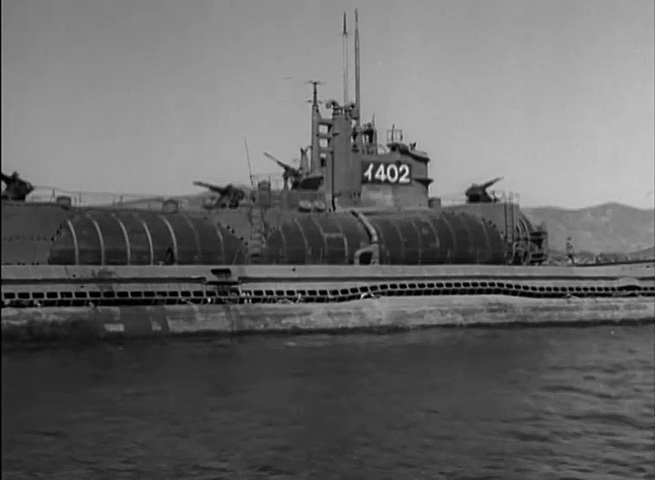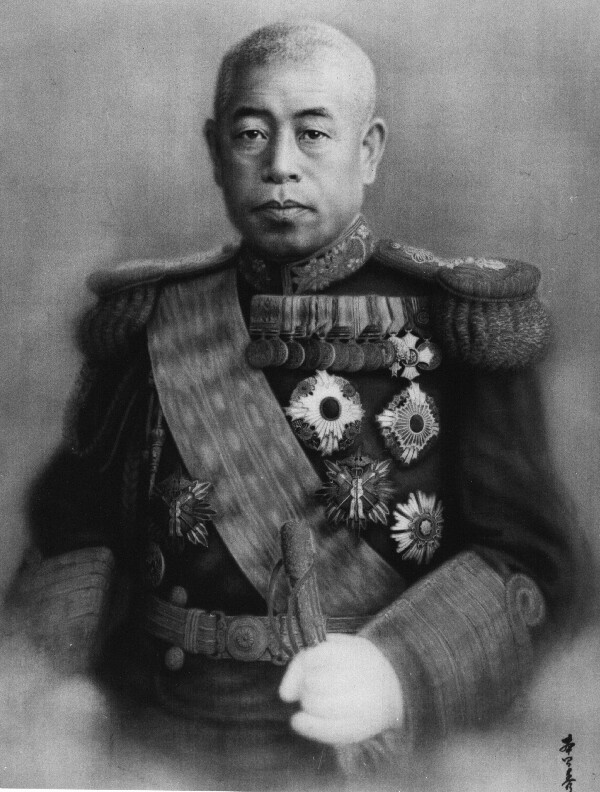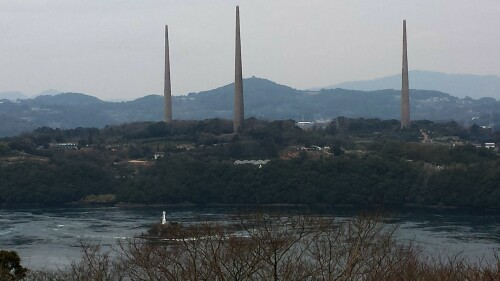The Supersubs of Sasebo
A Short History of the I-400-class Submarines Made in Sasebo, Japan
伊400型 ― 佐世保のスーパー潜水艦
A Short History of the I-400-class Submarines Made in Sasebo, Japan
伊400型 ― 佐世保のスーパー潜水艦
| Sasebo History | Main Index |
The I-400-class submarines were huge. Construction started in January 1943, and up to that time they were the largest subs ever made in the world... and probably the deadliest. They were called Sensui Kubo -- submarine aircraft carriers -- able to hold three top-secret folding-wing attack bombers, the Aichi M6A Seiran.
Out of a total of eighteen super-subs planned, only five made it into the construction stage, and only four into actual operation. The I-400 (Dec. 1944) and I-404 (July 1944) were built in Kure (near Hiroshima), and the I-405 in Kawasaki, though cancelled during construction. Two of the super-subs were constructed in Sasebo -- the I-401 completed in Jan. 1945 and the I-402 (designed to be a tanker) in July of the same year. Able to cross the Pacific Ocean four times without refueling, armed with five deck guns, fire state-of-the-art torpedoes from eight tubes, and having special radar systems and sound-dampening hull coatings, these subs would be an awesome force facing the Allies.
The super-subs were planned by the same man who planned the Pearl Harbor attack -- Isoroku Yamamoto -- who wanted them to stealthily attack coastal cities in the US, e.g. Los Angeles and New York. As the war situation worsened for Japan, planning became even more ominous -- bombing Panama Canal and dropping infected fleas and rats on West Coast cities. Providentially, those ideas never came to fruition. Nor was Yamamoto ever to see the fruition of his own dream super-submarines -- he was killed during a tour of the South Pacific when his plane was shot down over Bougainville Island on April 18, 1943.
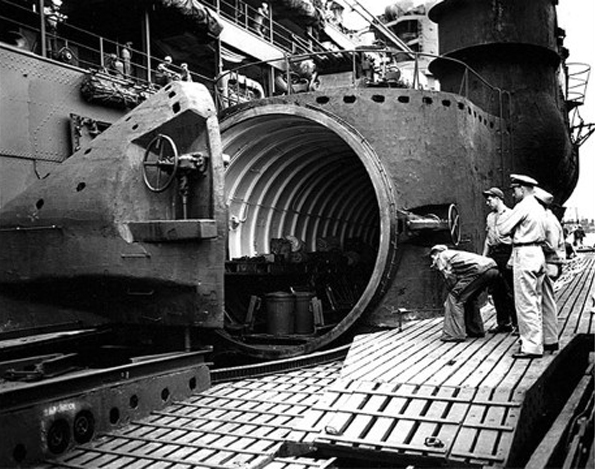
What really made the I-400's formidable was their ability to carry three attack aircraft in a huge cylindrical room in the middle of the deck, the conning tower offset to accomodate the storage area for these planes. The subs could stealthily go anywhere and their planes attack any Allied port city in the world. The special aircraft were called Seiran -- out of the clear blue sky, a storm. Indeed, it was out of the blue, for none of the Allied nations knew about the existence of this top-secret attack bomber.
A total of 28 of these special bombers were produced, though none were actually used for what they were designed -- to attack Panama Canal and demolish the first locks, the Gatun, on the Atlantic side. The special "kamikaze" attack squadron (consisting of the I-400 and I-401) was called Dragon God. Their mission was to head to the Panama Canal and take out the Gatun Locks. The captain of the I-401 was Lt. Com. Nobukiyo Nambu, having arrived earlier in Sasebo on November 1, 1944. He was later joined on the sub by the Commander of First Submarine Fleet, Tatsunosuke Ariizumi.
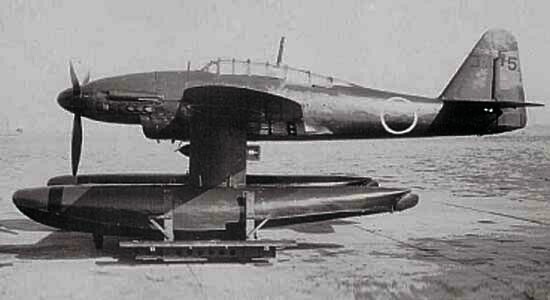
M6A1 Seiran 晴嵐
US military intelligence got word of this new plane sometime
in the fall of 1944. See this report of Nov. 3, 1944.
Their mission, however, was changed, due to the loss of Okinawa. They were to head to the South Pacific to attack US naval forces staging in Ulithi Atoll for their assault on mainland Japan. However, the war ended while the squadron was enroute, and all armament and planes were thrown into the sea. And for good reason -- the bombers were painted silver with American naval star insignias on them, a clear violation of international law. Interestingly, one of the mechanics on board the I-401 felt it was shameful and just before disposing of the aircraft he was in charge of, painted the red sun over each of the white stars.
But the end was not yet in sight for the I-400's. They were to become centers of attention for the American military. The I-400 and I-401 were captured at the end of the war and ordered to sail to Yokosuka (see this archival document recording the capture of the I-14, I-401 and I-402). They then went to Sasebo in Nov. 1945 to load up supplies, and then sailed for Hawaii a month later for intensive study. In late May and early June 1946, the two I-400's finally met their doom when they were scuttled at sea near Hawaii, being used as target practice (wreckage discovered in 2013). Only the I-402 remained in Japan, having been commandeered in Kure by US Forces where she was in port at the time, then later taken to Sasebo along with a number of other submarines. All these subs, including the I-402, were scuttled on April 1, 1946, in an operation known as "Roads End" (archival video links below). The final resting place of the Sasebo Supersub I-402 is now at the bottom of the sea between southern Goto Island and Nagasaki City. The wreckage was discovered by the Japan Coast Guard on Aug. 7, 2015.
| In the Japanese version of
Scapa Flow, 15 Sixth Fleet subs were slated for destruction. The I-402
was among the first to go. Early on the morning of April 1, 1946, in an
operation called Road's End, a skeleton crew of Japanese sailors
piloted their subs out of Sasebo harbor. One crew fastened cherry
blossom sprigs to their sub's sail; another painted their sail bright
green. Escorted by U.S. naval ships, the subs were led 60 miles off
shore, where the water was 100 fathoms deep. Once the subs arrived,
their crews were removed while demolition experts set explosive
charges. Shortly after 1:00 P.M. the detonations began. The I-402 avoided that ignominious end, but not for long. Lashed to a second sub, she was used for target practice by the USS Everett F. Larson (DD-830). When the two subs stubbornly refused to sink, they were scuttled. Ariizumi must have been rolling in his grave. Four days later nine more Japanese subs were scuttled, leaving only a handful of Sixth Fleet subs at Pearl Harbor. The I-14 was next. On May 28, 1946, she was taken eight miles off shore and used to test the newly developed Mark 10-3 exploder. The USS Bugara (SS 331) did the honors. Three days later the I-401 followed. At 10:51 on the morning of May 31, the USS Cabezon (SS 334) fired two torpedoes. Seven minutes later Nambu's sub was gone. On June 4 it was the I-400's turn. The newly commissioned USS Trumpetfish (SS 425) hosted distinguished guests for the fireworks, including Lockwood's replacement and a medal of honor winner. As a PBY Catalina Flying Boat filmed the destruction, the Trumpetfish fired three Mark 18-2 torpedoes. One torpedo prematured, the other two struck in a sensational eruption of metal, foam, and fury. The I-400, the last of the great underwater aircraft carriers and the final Japanese submarine sunk by the United States during World War II, went down by the stern. - From Operation Storm: Japan's Top Secret
Submarines and Its Plan
to Change the Course of WWII by John Geoghegan (2013) |
Truly the I-400's were amazing vessels. Much like there is a museum in Kure for the largest battleship created by Japan, the Yamato, perhaps there will one day be a museum in Sasebo detailing the history of Japan's largest submarines.
Documentary:
Japanese Super Sub - Secret Weapon (2009) (dubbed in Japanese, in 8 parts)
Japanese Submarines that Surrendered (April 2011; courtesy of Waller)
Archival documents:
Characteristics of Japanese Naval Vessels: Submarines (USN, Jan. 11, 1946)
The capture of the I-14, I-401 and I-402 (Feb. 11, 1946)
Archival videos:
Sinking Japanese Subs in
Operations (Roads End) 4/1/1946 (9:21)
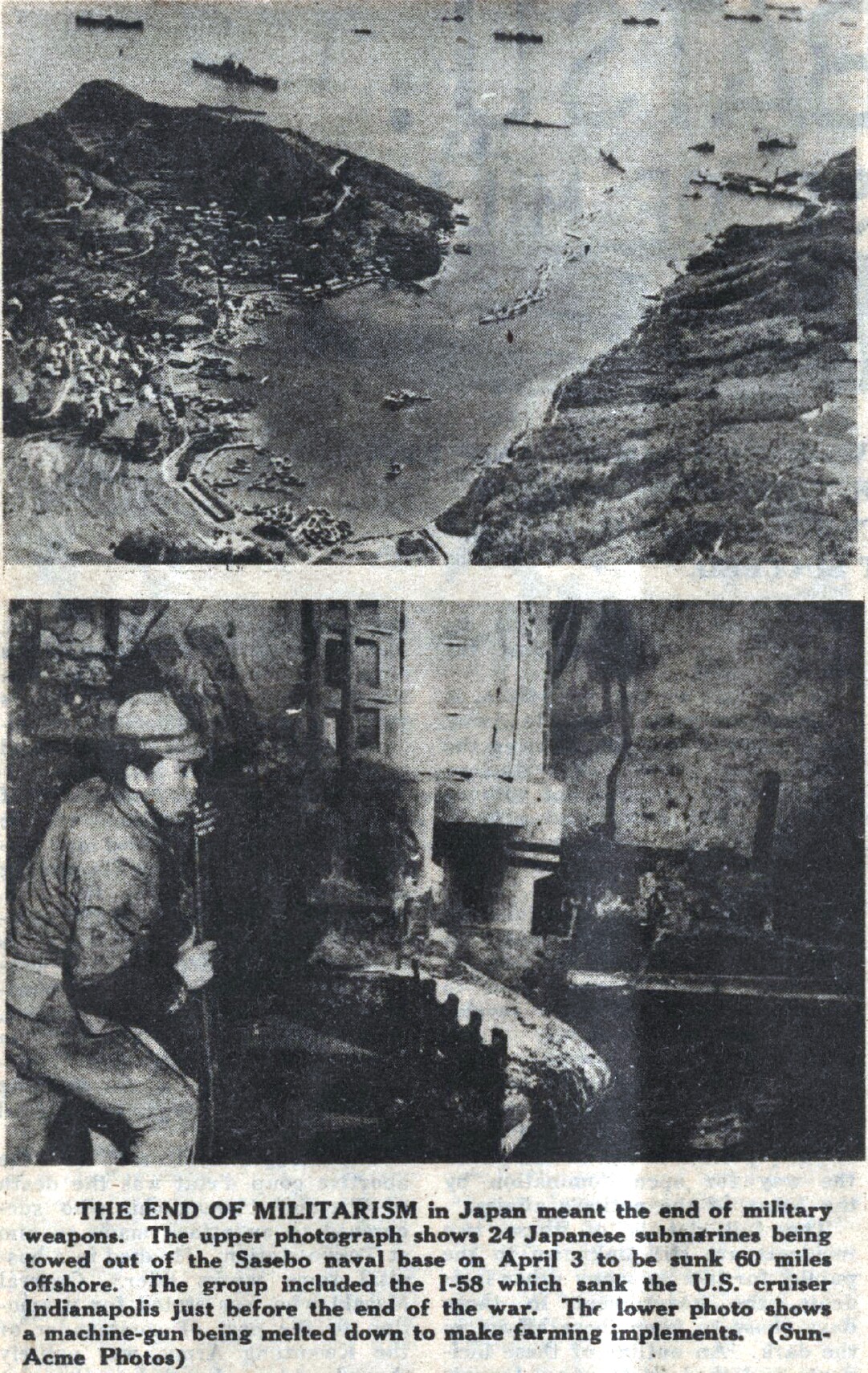
1) LS Japanese subs being sunk
after end of war by units of US fleet. 2) MS Japanese sub exploding and
sinking (SV). 3) MS Japanese sub exploding and sinking. 4) LS Sub in
water sinking. 5) LS Large, white spray of water high in air as
Japanese sub is sinking. 6) LS Japanese sub being sunk by units of US
fleet, near Sasebo, Japan. 7) MS Smoke rising from Japanese sub (SV).
8) AtoG MS Japanese subs. 9) MS Japanese crew taken off of sub prior to
sinking. 10) AtoG MS Explosions in water throwing up white spray (SV).
Sinking Of
Captured Japanese Submarines 4/1/1946 (10:50)Summary: AVs, fleet of Japanese
submarines lying in cove at Sasebo Bay. American Navy crews opening
boxes of demolition charges aboard Japanese submarine #402. Party
consisting of Admiral Robert M Griffen and others go below one of the
smaller submarines. Opening door of hangar of the 402 that can carry 4
planes. Admiral Griffen walks inside the hangar. Scenes taken from
craft showing different submarines in the cove. Admiral Griffen goes
aboard submarine 158 accompanied by party. The 158 is the submarine
which sunk the USS Indianapolis. Japanese putting cherry blossoms in
the periscope of submarine. CUs, Capt Atogi Nakamura and Lt Tashio
Tanaka. The latter is the officer who fired torpedoes which blew up the
Indianapolis. LS, crew of the 158. Sequence: aboard destroyer USS
Larsen: MCU, Commander F A McKee, on the bridge with Capt Bell, acting
commodore of the destroyer squadron. Also in scene is Japanese
interpreter giving instruction thru megaphone. Several scenes showing
destroyer convoy in bg. From bridge of the Larsen: scenes of the
world's largest sub, #402 being sunk by the Larsen's gunfire. LSs, of
other subs being sunk by gunfire. MS, naval guns being fired.
[Colorized footage]
Damaged Japanese
Ships, Sasebo Bay 9/1945 (8:00)[Colorized footage]
1) LS Rusted Japanese submarine
in Sasebo Bay. 2) LS MS <*>Japanese carrier at anchor in Sasebo
Bay. 3) CU Starboard side of damaged Japanese carrier, with submarine
tied up alongside (SV). 4) MS Various Japanese fishing craft and small
tugs tied up at docks (SV). 5) MS <*>Portion of Japanese town and
factories in BG (SV). 6) CU <*>RADM. MORTON L. DEYO with staff
members, Japanese officers, and interpreters inspecting the damaged
destroyer, SUZUTSUKI (SV).<*><*> 7) LS <*>Same in
sheltered cove, Sasebo Seaplane Base (SV)
Damaged Japanese
Ships, Sasebo 9/28/45 (5:39)LS Japanese drydocks and
submarineways, cranes and etc. at Sasebo Naval Base.LS Camouflage
Japanese ships, freighter tied up to docks-SV.LS Cruisers, SANTA FE
& WICHITA
Scenes In Sasebo
Harbor, Japan 9/24/1945 (7:10)1) MS APA at anchor shore in BG.
2) MS Several LCT"s at anchor unloading tanks. 3) MS Bulldozer pulls
out of LCT. 4) LS PAN Fishing at village waterfront, Sasebo Harbor. 5)
LS Japanese worker in small boat. 6) LS Japanese wooden boat tied up in
Sasebo Harbor (SV). 7) CU Same.8) LS Crane unloads supplies from AKA in
docks at harbor. 9) LS PAN Waterfront on Sasebo showing boats, cranes,
buildings, etc. 10) MS Sailors leave LST and go ashore. 11) MS Japanese
police directing traffic in Sasebo. 12) MS Hdqts. bldg. of Marine
Amphibious Corps. 13) MS Sailor takes still picture of damage in
Sasebo. 14) LS PAN Many buildings damaged wreckage. 15) MS Street scene
Japanese pulls ricksha.16) LS Custom house and boat landing.
Physical Damage,
Aerial Coverage Cities Of Japan 4/12~13/1946 (11:19)Omuta: 19' Flight line flown on a
heading of 207 degrees magnetic. 21' Same as above. 17' Same as above.
16' Flight line flown on a heading of 270 degrees magnetic.
Sasebo: 47' Flight line flown on a heading of 340 degrees magnetic. Two passes on Naval Air Station starting on the E side and showing also a portion of the burned-out urban area. Gas dump on fire on a small island of Sasebo Harbor. 13' Flight line flown on a heading of 340 degrees magnetic, over Naval Air Station. 40' Flight line flown on a heading of 332 degrees magnetic showing Sasebo Aircraft Factory. 25' Flight line flown on a heading of 58 degrees magnetic over Sasebo. 12' Same as above. 11' Same as above. 12' Three aircraft carriers beached in a small cove S of Sasebo Harbor.
Omura: 13' Flight line flown on a heading of m magnetic. Nine passes made over factory area and airfield starting along the water. 20' Same as above. 17' Same as above. 17' Same as above. 13' Same as above. 11' Same as above. 21' Passes over Factory area and Airfield starting at edge of water. 27' Same as above. More inland.
Sasebo: 47' Flight line flown on a heading of 340 degrees magnetic. Two passes on Naval Air Station starting on the E side and showing also a portion of the burned-out urban area. Gas dump on fire on a small island of Sasebo Harbor. 13' Flight line flown on a heading of 340 degrees magnetic, over Naval Air Station. 40' Flight line flown on a heading of 332 degrees magnetic showing Sasebo Aircraft Factory. 25' Flight line flown on a heading of 58 degrees magnetic over Sasebo. 12' Same as above. 11' Same as above. 12' Three aircraft carriers beached in a small cove S of Sasebo Harbor.
Omura: 13' Flight line flown on a heading of m magnetic. Nine passes made over factory area and airfield starting along the water. 20' Same as above. 17' Same as above. 17' Same as above. 13' Same as above. 11' Same as above. 21' Passes over Factory area and Airfield starting at edge of water. 27' Same as above. More inland.

|
SIDE NOTES ON ISOROKU YAMAMOTO
Yamamoto frequently came to Sasebo during his naval career. During one visit when he was 28 years old, he met Kotaro, a beautiful young girl (very young at 12 years old), at a geisha house called Takara-ya. Her real name was Tsuru Tsurushima, born in Isahaya, also called Masako, and she was to become Yamamoto's first love. She was so attractive that one magazine featured her on the front page with the caption, "The Flower of Kyushu." Yamamoto and Masako developed a lasting relationship and would often write to each other. She later opened up her own teahouse in Sasebo, called Togo. Masako had always felt that someday Yamamoto would become an admiral, and when in fact he did, she went to visit him when he arrived in Beppu in late 1940. They met again in 1941 when Yamamoto made sure to visit her teahouse. Agawa related in his book: "...during the four or five days that the fleet was in port, Masako would not let anyone else attend to Yamamoto's needs. The short time that she spent waiting hand and foot on the man she had loved ever since she was twelve was the happiest in her whole life." Masako kept all the letters from Yamamoto, but so that the Navy could not find them, locked them up in a suitcase. They were all destroyed in the fires after B-29's bombed Sasebo in June 1945. Masako died in Sasebo on November 11, 1968. Per Hoyt in his book on Yamamoto, 1990: "In Sasebo I wanted to
interview Masako Tsurushima, one of the geisha
who was extremely close to Yamamoto, but I discovered that she had
moved way to the south and was living in seclusion. The new proprietors
of the Togo restaurant were
very kind to show me around what had been
one of Yamamoto's favorite haunts and to point out an example of his
calligraphy that hangs above the front doorway."
And a few other side notes, the Sasebo Sixth Special Land Unit was based in Buin on Bougainville Island and was the unit which dispatched one of the search parties to find Yamamoto's body after his plane was shot down on April 18, 1943. Though an Imperial Army search party had originally found the wreckage, it was this Navy team who recovered the bodies and who oversaw the cremation of the remains. In November 1942, Adm. Chuichi Nagumo, who led the fleet strike force to attack Pearl Harbor, was "banished" from his South Pacific command and sent to Sasebo to take over leadership there, where he remained until after Yamamoto's death. Yamamoto was glad to be "rid" of him, knowing Nagumo could no longer "damage" the Navy. The animosity apparently stemmed from Yamamoto's disapproval of Nagumo's "strategic failures" during the Pearl Harbor attack. The "Climb Mount
Niitaka 1208" Message
It is somewhat of a mystery from which of the communication units this actual message was sent. It was known as Yamamoto's "Great Navy Order Number 12" and was transmitted to fleet commanders advising when the attack on Pearl Harbor was to commence. Was it really sent, as some have conjectured, from the Sasebo Naval Communications Unit's huge radio towers in Hario? The message was transmitted in a special top-secret code which was developed by Yamamoto, called the "Admirals' Code," which US intelligence was unable to decipher at the time. Since Emperor Hirohito gave permission to Navy Chief of Staff Osami Nagano to send out the message on Dec. 2, it can be surmised that it originated from either the Tokyo or the Yokosuka Naval Communications Units. Admiral Yamamoto also sent out the message to his fleet from his flagship, the Nagato, which was in the Inland Sea at the time. 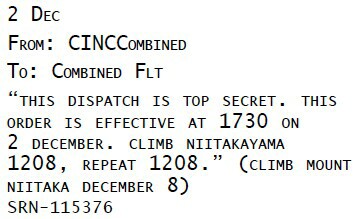 |
